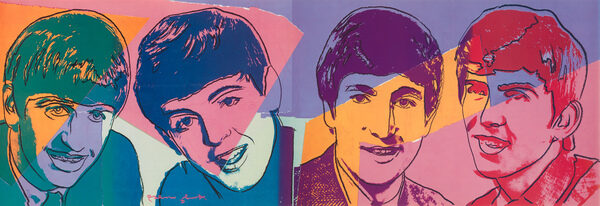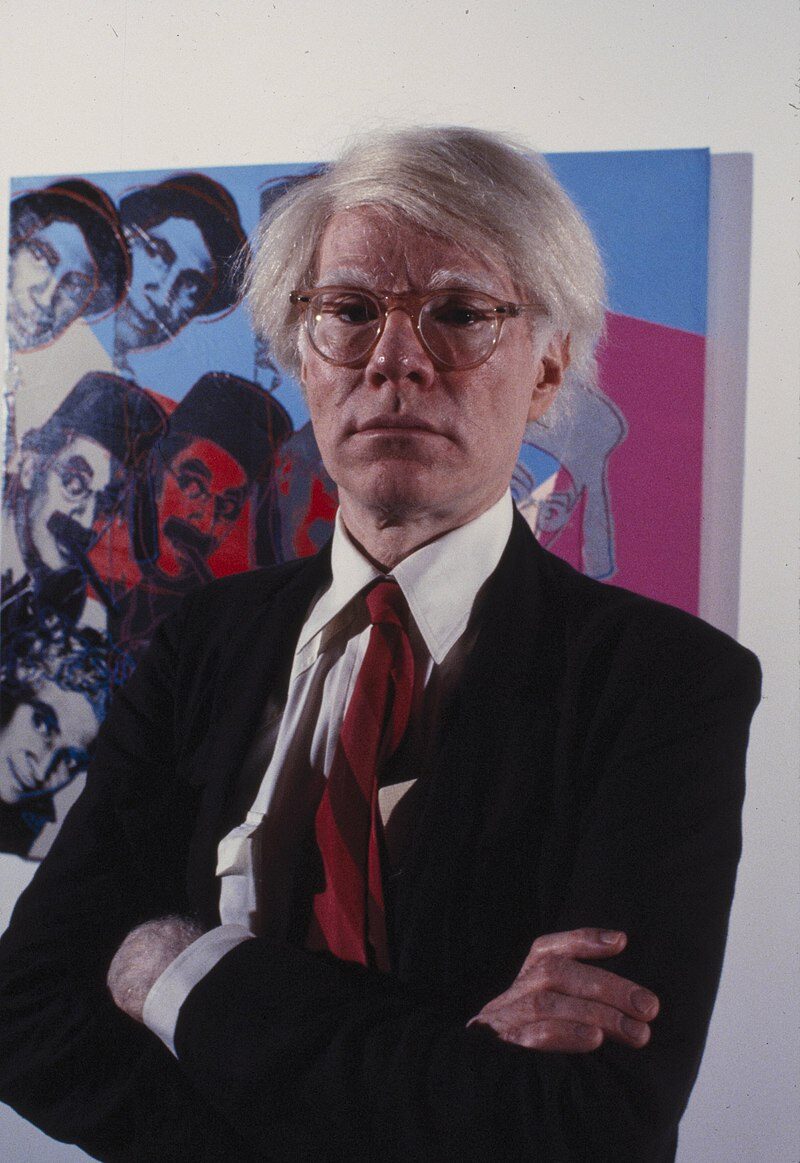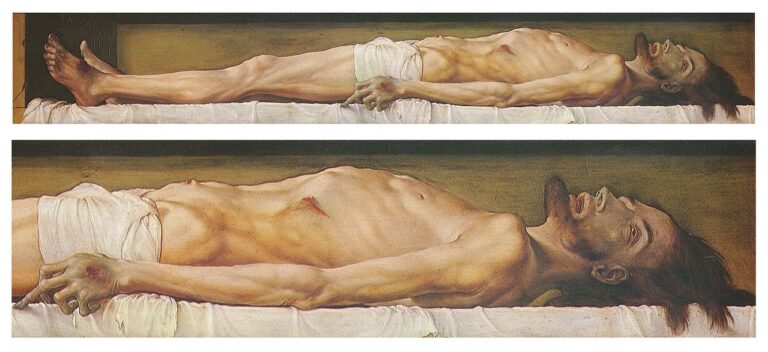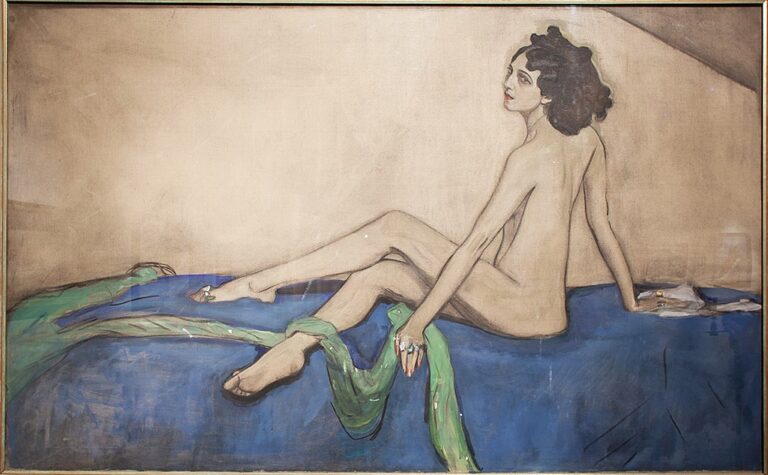Andy Warhol Painter: A Revolutionary Force in Pop Art
Born: August 6, 1928, Pennsylvania, U.S.
Death: February 22, 1987, New York City, U.S.
Art Movement: Pop art
Nationality: American
Institution: Carnegie Institute of Technology
Andy Warhol Painter: A Revolutionary Force in Pop Art
Andy Warhol’s Biography
Andy Warhol transformed American art with his iconic pop art images and unique approach to celebrity culture. His journey from commercial illustrator to world-famous artist reshaped how we think about art and fame.
Early Life and Education
Andy Warhol was born Andrew Warhola on August 6, 1928, in Pittsburgh, Pennsylvania to Slovakian immigrant parents. As a child, he suffered from a nervous system disease that kept him bedridden for long periods.

Electric Chair, 1971 by Andy Warhol
During these times, he drew, collected pictures of movie stars, and developed his artistic skills. His mother, Julia Warhola, encouraged his creative interests.
Warhol attended Carnegie Institute of Technology (now Carnegie Mellon University) from 1945 to 1949. He studied commercial art and graduated with a Bachelor of Fine Arts degree in Pictorial Design.
After graduation, he moved to New York City to pursue a career in commercial illustration. His early work included advertisements for shoe companies and magazine illustrations.
Development of Pop Art Style
In the late 1950s, Warhol began transitioning from commercial art to fine art. He developed his signature style of taking ordinary consumer items and transforming them into art.
His first pop paintings featured comic strips and advertisements. By 1962, he had created his famous Campbell’s Soup Cans series, which featured 32 canvases of soup cans – one for each flavor.
Warhol pioneered the silkscreen printing process for making paintings. This technique allowed him to mass-produce images, challenging traditional ideas about art’s uniqueness.
His studio, known as “The Factory,” became central to his artistic process. There, he employed assistants to help produce his works in an assembly-line fashion – intentionally mimicking consumer culture.
His color palette became bold and simple, using vibrant colors that reflected commercial advertising techniques.
Rise to Fame
Warhol’s first major exhibition was in 1962 at the Ferus Gallery in Los Angeles. His Campbell’s Soup Cans created immediate controversy and attention in the art world.
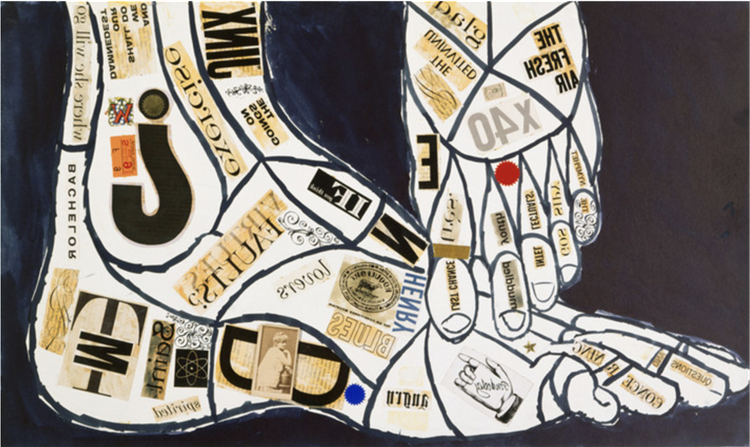
Feet, 1959 by Andy Warhol
His portraits of celebrities like Marilyn Monroe, Elvis Presley, and Elizabeth Taylor brought him widespread recognition. These works blurred the line between commercial imagery and fine art.
In 1964, Warhol held his first New York exhibition at the Stable Gallery. The show featured sculptures of Brillo boxes and other consumer products, further challenging what could be considered art.
By the mid-1960s, Warhol had become a celebrity himself. His distinctive appearance – pale skin, silver wig, and sunglasses – became part of his artistic identity.
He expanded into filmmaking, producing experimental films like “Empire” (1964) and “Chelsea Girls” (1966). These films, often featuring his Factory “superstars,” were as provocative as his paintings.
Collaborations and Influences
Warhol’s Factory attracted diverse creative talents, including musicians, writers, and performers. This environment fostered unique collaborative relationships.
He managed and produced the rock band The Velvet Underground in 1967. Their album cover featuring a banana image designed by Warhol became iconic in music history.
Warhol’s magazine, “Interview,” launched in 1969. It featured conversations with celebrities and became an important platform for pop culture discussion.
His work influenced numerous artists, including Jean-Michel Basquiat, with whom he collaborated in the 1980s. These collaborations merged Warhol’s pop sensibility with Basquiat’s neo-expressionist style.
Fashion designers and musicians sought his creative input. He designed album covers for The Rolling Stones and created artwork for fashion brands.
Later Years and Legacy
In 1968, radical feminist Valerie Solanas shot Warhol in his studio. He survived but suffered health complications for the rest of his life.
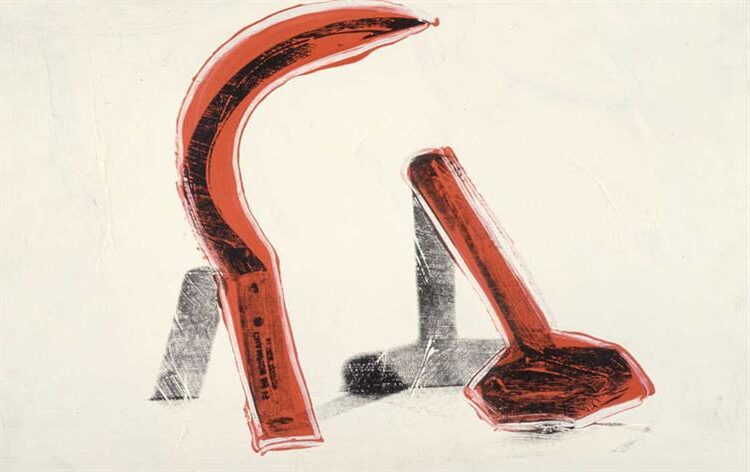
Hammer and Sickle, c.1976–c.1977 by Andy Warhol
After the shooting, Warhol’s work became more commercial. He focused on portrait commissions from celebrities and wealthy clients, charging $25,000 per portrait.
Throughout the 1970s and 1980s, he remained a fixture in New York’s social scene. His presence at Studio 54 and other nightclubs cemented his status as a cultural icon.
Warhol died on February 22, 1987, at age 58 from complications following gallbladder surgery. His unexpected death shocked the art world.
The Andy Warhol Museum in Pittsburgh houses the largest collection of his artworks and archives. His estate became The Andy Warhol Foundation for the Visual Arts, which continues to support contemporary art.
Iconic Works and Techniques
Andy Warhol created revolutionary artwork that forever changed the art world through his distinctive style and innovative methods. His most famous pieces capture American consumer culture and celebrity fascination while introducing new approaches to creating art.
Campbell’s Soup Cans
Warhol’s 1962 “Campbell’s Soup Cans” features 32 paintings, each depicting a different variety of Campbell’s soup. The work launched Warhol into the spotlight of the art world and became a defining piece of Pop Art.
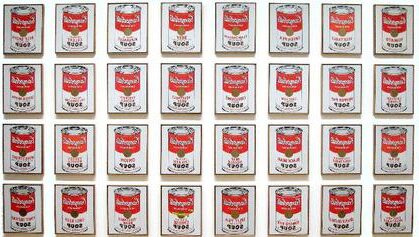
Campbell’s Soup Cans, 1962 by Andy Warhol
Each canvas measures 20 by 16 inches and shows a soup can painted to resemble the commercial packaging consumers encountered daily in supermarkets.
The series represented Warhol’s embrace of commercial imagery and challenged traditional notions about what constituted “fine art.” The repetition of nearly identical images reflected mass production in American society.
Warhol chose Campbell’s soup because he ate it for lunch nearly every day for 20 years, making the mundane product personally significant.
Marilyn Diptych
Created shortly after Marilyn Monroe’s death in 1962, the “Marilyn Diptych” consists of fifty images of the actress based on a publicity photograph from the film “Niagara.”
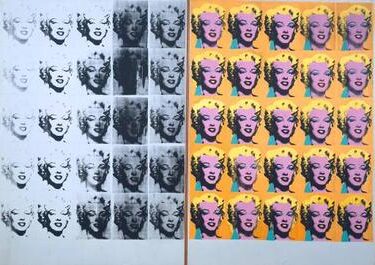
Marilyn Diptych, 1962 by Andy Warhol
The left side features vibrant, colorful reproductions while the right displays black and white images that fade and blur, creating a powerful commentary on celebrity, mortality, and fame.
Measuring 6 feet wide, the piece exemplifies Warhol’s fascination with celebrity culture and his ability to transform publicity photos into powerful artistic statements.
The repetition technique creates a visual effect similar to watching repeated frames in a film, reinforcing Monroe’s status as a movie icon while suggesting how media exposure both creates and destroys celebrity identities.
Silver Car Crash (Double Disaster)
“Silver Car Crash (Double Disaster)” from 1963 belongs to Warhol’s “Death and Disaster” series. This large silkscreen painting (8 by 13 feet) depicts a gruesome car accident scene repeatedly printed on the left panel, paired with a blank silver panel on the right.
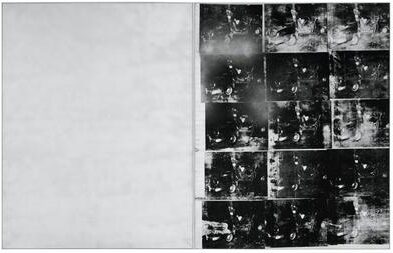
Silver Car Crash (Double Disaster), 1963 by Andy Warhol
The work sold for $105 million in 2013, becoming one of the most expensive Warhol pieces ever auctioned.
Unlike his celebrity portraits, this series examined how media desensitizes viewers to tragedy through repetition of violent imagery. The blank silver panel creates space for reflection about mortality and our relationship to disaster imagery.
The high-contrast black silkscreen on silver paint creates a cold, detached aesthetic that mirrors newspaper photography of the era.
Silkscreen Printing Innovations
Warhol revolutionized art production by adopting commercial silkscreen printing techniques in 1962, abandoning traditional hand painting methods for most of his career.
The process involved:
- Selecting a photograph
- Converting it to a high-contrast image
- Transferring it to a silk mesh screen
- Pushing ink through the screen onto canvas
This technique allowed Warhol to produce multiple versions of images with variations in color and alignment, creating both precision and intentional imperfections.
The method’s mechanical nature aligned perfectly with Warhol’s artistic philosophy: “I want to be a machine.” It enabled him to create art that commented on mass production while actually embodying those same principles.
Exploration of Consumerism and Celebrity
Warhol’s work directly engaged with post-war American consumer culture, transforming everyday products and famous faces into subjects worthy of artistic contemplation.
He blurred boundaries between commercial and fine art by elevating brand logos, product packaging, and advertising imagery to gallery status. His famous quote, “I like boring things,” reflected his interest in objects most people overlooked.
For celebrity portraits, Warhol applied similar techniques to famous subjects including Elvis Presley, Elizabeth Taylor, and Mao Zedong. These works examined fame as a manufactured product.
His studio, “The Factory,” functioned as both art production facility and social scene, reinforcing the connection between art-making and celebrity culture that defined his career.
Cultural Impact and Criticism

The Last Supper, 1986 by Andy Warhol
Andy Warhol transformed the art world through his innovative approach to commercial imagery and celebrity culture. His work challenged traditional notions of artistry and continues to influence contemporary artists, critics, and popular culture worldwide.
Influence on Modern Art
Warhol’s influence on modern art remains profound and far-reaching. His screen-printed images of consumer products and celebrities revolutionized how artists approached subject matter. By elevating everyday objects to the status of fine art, he blurred the line between high and low culture.
Artists like Jeff Koons, Damien Hirst, and Takashi Murakami directly draw from Warhol’s techniques and themes. His Factory studio model also created a template for collaborative art production that many contemporary artists emulate.
The concept of artist-as-celebrity that Warhol pioneered is now standard practice in the art world. His declaration that “everyone will be famous for 15 minutes” accurately predicted today’s social media culture and celebrity obsession.
Contributions to Visual Art Discourse
Warhol fundamentally changed how we think about art and its purpose. His work prompted serious questions about originality, authenticity, and mechanical reproduction in art.
His statement “I want to be a machine” challenged romantic notions of artistic inspiration. By employing commercial printing techniques, he questioned the importance of the artist’s hand in creating meaningful work.
Warhol’s practice of appropriating existing images sparked important debates about copyright and ownership that continue today. His approach to art-making influenced entire movements, including:
- Appropriation art
- Neo-conceptualism
- Relational aesthetics
- Post-internet art
These philosophical contributions have become as important as his physical artworks.
Critiques of Warhol’s Approach and Themes
Despite his success, Warhol faced significant criticism throughout his career. Many critics viewed his work as shallow, lacking intellectual substance, and overly focused on commercial values rather than artistic merit.
Art critic Robert Hughes famously called Warhol “the white mole of Union Square,” suggesting his work was a destructive force undermining artistic tradition. Others criticized him for:
- Celebrating consumerism without critique
- Promoting empty celebrity worship
- Producing work too easily reproducible
- Being overly concerned with the art market
Some viewed his emotional detachment as problematic. His seemingly passive response to tragic subjects like car crashes and suicides in his Death and Disaster series raised ethical questions about exploiting suffering for artistic purposes.
Enduring Pop Culture Presence
Warhol’s impact extends far beyond gallery walls into mainstream culture. His visual style has been appropriated by countless advertisers, fashion designers, and media producers.
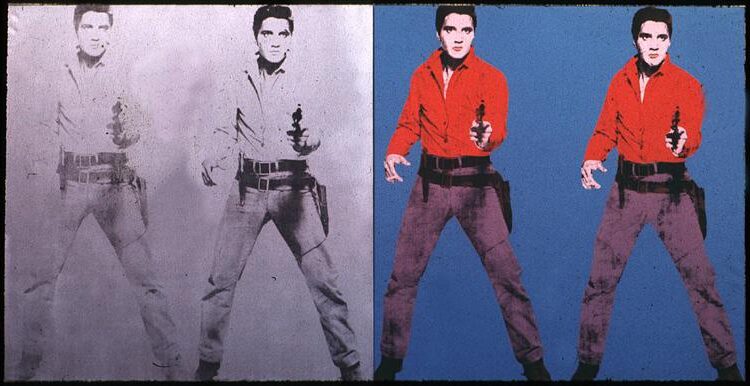
Elvis I & II, 1963 by Andy Warhol
His iconic portraits of Marilyn Monroe, Campbell’s soup cans, and dollar signs appear on everything from t-shirts to home decor. The Warhol aesthetic has become visual shorthand for “hip” and “artistic” in commercial contexts.
Cultural institutions continue celebrating his legacy. The Andy Warhol Museum in Pittsburgh houses the largest collection of his work and remains a major tourist attraction. His paintings regularly break auction records, with his “Shot Sage Blue Marilyn” selling for $195 million in 2022.
Warhol’s personal style—the silver wig, leather jacket, and deadpan persona—has become as recognizable as his art. Contemporary celebrities like Lady Gaga cite him as a direct influence on their public image.
Frequently Asked Questions
Andy Warhol’s revolutionary painting style transformed art through innovative techniques, iconic imagery, and unique artistic philosophies. His work continues to generate questions about his methods, influences, and significance in art history.
What distinguishes Andy Warhol’s painting style within the Pop Art movement?
Warhol distinguished himself through his bold use of commercial imagery and mechanical reproduction methods. Unlike other Pop artists, he embraced mass production techniques as part of his artistic process.
His work deliberately blurred the line between high art and consumer culture. Warhol’s flat, impersonal style removed traditional artistic expression and emphasized repetition.
He often used bright, artificial colors that mimicked advertising and mass media. This approach challenged conventional notions of artistic originality and craftsmanship.
Can you highlight some of Warhol’s most significant contributions to modern art?
Warhol democratized art by using everyday objects and celebrities as subjects. His work made fine art more accessible to the general public.
He pioneered the concept of the artist as a brand or business. The Factory, his New York studio, functioned as both an art production facility and social hub.
Warhol expanded the definition of art to include film, music, publishing, and performance. His interdisciplinary approach influenced generations of artists to work across multiple media.
Which techniques did Warhol employ to produce his iconic silkscreen paintings?
Warhol adapted commercial silkscreen techniques for fine art purposes. He would transfer photographic images onto silk screens using light-sensitive chemicals.
The process involved pushing ink through the screen onto canvas or paper. This allowed him to create multiple identical images with slight variations.
He often employed assistants to help with production. This factory-like approach to creation was itself a statement about modern art and society.
Could you discuss the significance of Warhol’s use of commercial images in fine art?
Warhol elevated everyday commercial products to the status of high art. His Campbell’s Soup Cans and Brillo Boxes challenged viewers to reconsider the value and meaning of ordinary objects.
By incorporating advertising imagery, Warhol commented on American consumer culture. He reflected society’s obsession with brands, celebrities, and mass production.
This approach removed traditional barriers between commercial design and fine art. Warhol’s work questioned the authenticity and originality valued in traditional art circles.
What are some of Warhol’s most iconic paintings, and what themes do they explore?
“Campbell’s Soup Cans” (1962) explored themes of mass production and the uniformity of consumer goods. The 32-canvas work presented mundane objects as subjects worthy of artistic attention.
“Marilyn Diptych” (1962) examined celebrity culture and mortality. Created shortly after Monroe’s death, the contrasting colorful and black-and-white panels suggest fame’s fleeting nature.
“Eight Elvises” (1963) and his electric chair series addressed fame, violence, and media desensitization. These works show how repeated images lose impact over time.
How did Andy Warhol’s background influence his approach to painting and art?
Warhol’s working-class upbringing in Pittsburgh shaped his appreciation for everyday American culture. His immigrant family background gave him an outsider’s perspective on American consumerism.
His early career as a commercial illustrator informed his artistic techniques. This professional experience provided both technical skills and an understanding of advertising’s power.
Warhol’s childhood health issues often kept him isolated. This experience may have contributed to his fascination with celebrities and his observer’s perspective on popular culture.

